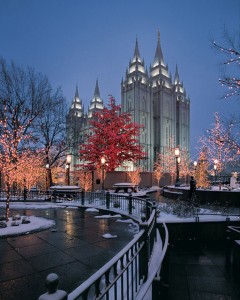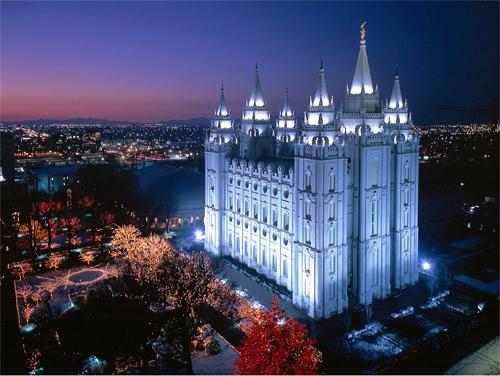 Under President David O. McKay, who was president and prophet of the Mormon Church from 1951 to 1971, the Mormon Church once again concentrated itself on missionary work. Under President McKay, every worthy young man was asked to serve as a Mormon missionary, and the number of Mormon missionaries grew from a few thousand in 1951 to tens of thousands by the 1970s. This brought about a worldwide increase of membership. Many new members lived in poor regions of the world and could not easily get to the temples in Utah, New Zealand, or Europe. President McKay began plans to build more, smaller temples throughout the earth, although larger temples would continue to be built in special locations. In 1964, a second temple was built in California, in Oakland, and twin temples were built in Ogden and Provo, Utah, in 1972. The Provo Temple, located near Brigham Young University and the Missionary Training Center, has become the busiest Mormon temple. All these temples were built to incorporate the films that made the presentation of the Mormon temple ceremonies simpler and quicker, and easier to translate into foreign languages.
Under President David O. McKay, who was president and prophet of the Mormon Church from 1951 to 1971, the Mormon Church once again concentrated itself on missionary work. Under President McKay, every worthy young man was asked to serve as a Mormon missionary, and the number of Mormon missionaries grew from a few thousand in 1951 to tens of thousands by the 1970s. This brought about a worldwide increase of membership. Many new members lived in poor regions of the world and could not easily get to the temples in Utah, New Zealand, or Europe. President McKay began plans to build more, smaller temples throughout the earth, although larger temples would continue to be built in special locations. In 1964, a second temple was built in California, in Oakland, and twin temples were built in Ogden and Provo, Utah, in 1972. The Provo Temple, located near Brigham Young University and the Missionary Training Center, has become the busiest Mormon temple. All these temples were built to incorporate the films that made the presentation of the Mormon temple ceremonies simpler and quicker, and easier to translate into foreign languages.
In 1974, the Mormon Church built the beautiful Washington D.C. Temple, the first temple since the Los Angeles Temple to include an assembly hall for special meetings. This beautiful temple has become a symbol of Mormonism’s growth, especially in the eastern United States, and includes a beautiful visitor’s center and its famous Christmas lights.
The 1970s also saw the growth of the number of temples in foreign lands. In 1978, the first Mormon temple in South America was built in Sao Paulo, Brazil, a country which has one of the largest populations of Mormons outside the United States. Temples were also begun in Tokyo, Japan; Apia, Samoa; Santiago, Chile; and Mexico City, Mexico. Each temple was beautifully crafted as an expression of Mormons’ worship of God. The Tokyo Temple, the first Mormon temple in Asia, was built after much sacrifice by the tens of thousands of Japanese who had joined the Mormon Church since the first Mormon missionaries arrived in 1901. Throughout the 1980s, temples were built in Washington State,  Georgia, Tonga, Tahiti, Australia, South Africa (the first on that continent), Sweden, and in numerous U.S states. Additional temples were built in California, Utah, and Idaho. In 1985, a temple was built in Korea, where Mormon missionaries had begun preaching following the Korean War. One of the most unlikely temples was the Freiberg Germany Temple, built in Soviet-controlled East Germany. Thomas S. Monson, then counselor to President Ezra Taft Benson, had previously overseen the Mormon Church’s operations in Europe and, through his friendships with East German leaders, obtained approval for the only Mormon temple in history in a communist land. It was dedicated in 1985. In 1987, a second German temple was built in West Germany, in Frankfurt am Main.
Georgia, Tonga, Tahiti, Australia, South Africa (the first on that continent), Sweden, and in numerous U.S states. Additional temples were built in California, Utah, and Idaho. In 1985, a temple was built in Korea, where Mormon missionaries had begun preaching following the Korean War. One of the most unlikely temples was the Freiberg Germany Temple, built in Soviet-controlled East Germany. Thomas S. Monson, then counselor to President Ezra Taft Benson, had previously overseen the Mormon Church’s operations in Europe and, through his friendships with East German leaders, obtained approval for the only Mormon temple in history in a communist land. It was dedicated in 1985. In 1987, a second German temple was built in West Germany, in Frankfurt am Main.
By the late 1980s and early 1990s, temple construction had become an almost constant phenomenon in the Mormon Church. Even faithful Mormons could not keep track of where every temple was located. In 1995, when Gordon B. Hinckley became the fifteenth prophet and president of the Mormon Church, there were 47 Mormon temples, which were located on every inhabited continent. There were 8 in Utah, 17 in the rest of the United States, 2 in Canada, 5 in Europe, 3 in Asia, 1 in Africa, 6 in South America, and 5 in Australia and the Pacific Islands.
Twitter •


 Watch a video about the restoration of the gospel on lds.org
Watch a video about the restoration of the gospel on lds.org
The Mormon Temples are very wonderful and so amazing to look at in this picture also in real view.! When Christmas comes this place just like heaven that has so much beauty of each display of Christmas lights and the place it self. Perfect holiday to go! Nice blog….thanks for sharing..